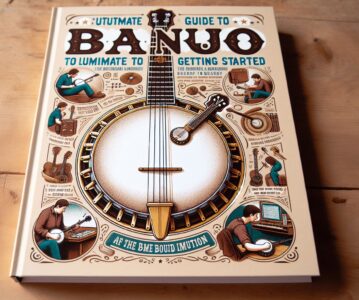If you’re new to the world of banjo, you’re in for a treat! This unique instrument has a rich history and a distinctive sound that’s sure to captivate both players and listeners alike. Whether you’re a fan of bluegrass, folk, or simply curious about the banjo, this guide is designed to help you understand the basics and get you strumming in no time.
Banjo Basics: Understanding the 5-String Banjo
Before diving into the details, let’s start with the basics. The banjo is a stringed instrument known for its circular body, long neck, and, of course, that signature twang. While there are different types of banjos, the most common one played today is the 5-string banjo.
The 5-string banjo typically has four strings tuned to a standard open G tuning, with a shorter fifth string peg located on the side of the neck. This fifth string, often referred to as the “thumb string,” adds a unique high-pitched sound to the banjo’s repertoire.
Getting Started: Choosing the Right Banjo
Now that you have a better understanding of the banjo, it’s time to select the right instrument for you. With so many options available, here are a few key factors to consider:
-
Budget: Determine how much you’re willing to invest in your banjo. Entry-level banjos can start as low as $200, while high-end professional models can reach several thousand dollars. It’s important to strike a balance based on your level of commitment and financial capacity.
-
Playing Style: Consider the genre or style of music you’re interested in playing. Traditional bluegrass banjoists often prefer open-back banjos, while resonator banjos are favored for their louder projection in a band setting. Take time to explore the different styles and identify what resonates with you.
-
Comfort: Pay attention to the weight, size, and neck profile of the banjo. You want an instrument that feels comfortable in your hands and allows for easy movement along the fretboard. Visit a local music store and try out different models to find the one that suits you best.
Essential Accessories: What You’ll Need
Once you’ve found your perfect banjo, there are a few essential accessories to complete your setup:
-
Picks: Banjo picking is typically done using fingerpicks attached to your thumb, index, and middle fingers. Experiment with different picks to find the ones that feel most comfortable to you.
-
Strap: A strap can provide added support and comfort during longer playing sessions. Look for one that’s adjustable and offers secure attachment points.
-
Tuner: Keeping your banjo in tune is crucial. There are various electronic tuners available to help you achieve accurate pitch. You can also consider using tuning apps on your smartphone.
-
Case or Gig Bag: Proper storage and transportation are essential to protect your banjo. Invest in a quality case or gig bag to keep it safe from dust, humidity, and accidental knocks.
Getting Acquainted: Basic Techniques
Now that you have your banjo and accessories, it’s time to get acquainted with the instrument and begin practicing. Here are a few fundamental techniques to get started:
-
Strumming: Start by strumming the open strings with your thumb or fingers using a downward motion. Experiment with different rhythms and try to find a consistent, steady tempo.
-
Chords: Learn basic banjo chords, such as G, C, and D. Familiarize yourself with the finger positions and practice transitioning between them smoothly. As you gain confidence, expand your chord repertoire to increase your playing versatility.
-
Rolls: Rolls are a series of fingerpicking patterns that give the banjo its distinctive sound. The most common rolls include the forward roll, backward roll, and alternating thumb roll. Practice each roll slowly and gradually increase your speed.
-
Melodies: Once you feel comfortable with chords and rolls, start learning simple melodies. Begin with folk tunes or traditional songs that you’re familiar with. There are plenty of online resources, books, and tutorials available to guide you through the learning process.
The Journey Ahead: Embracing the Banjo
As with any musical instrument, learning to play the banjo is a journey that requires patience and dedication. Here are a few parting tips to keep in mind as you progress:
-
Practice Regularly: Consistency is key. Set aside dedicated practice time each day and gradually increase your playing sessions. Aim for quality over quantity, focusing on proper techniques, rhythm, and precision.
-
Join a Community: Seek out fellow banjo enthusiasts by joining local jam sessions, workshops, or online forums. Surrounding yourself with like-minded individuals can provide invaluable support, inspiration, and opportunities for collaboration.
-
Stay Inspired: Listen to banjo music across different genres. Explore the works of renowned banjo players and let their playing style influence your own. Attend concerts or watch live performances to expand your musical horizons.
-
Celebrate Progress: Banjo playing is a lifelong journey, so remember to celebrate every milestone along the way. Even the smallest improvements are worth acknowledging, as they contribute to your growth as a musician.
In conclusion, the banjo is a versatile and engaging instrument that will reward your time and effort. Embrace the twang, familiarize yourself with the 5-string banjo, and dive into the world of banjo music. With dedication and a sense of adventure, you’ll soon find yourself strumming away and delighting others with the unique sound of this captivating instrument.


